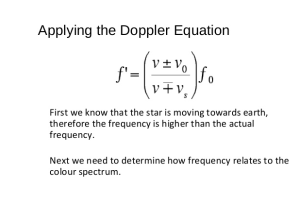

This also applies to any other conditions, whether both the source & observer are moving towards each other, away, or even at the same direction(just at different velocities). In other words, if the car and Person $Y$ were moving at $3.5m/s$ towards each other, it would be the same as if the Car was moving pass the Stationary Person $Y$, with $v=7m/s$. If I were to use this logic in Doppler Effect, it doesn't matter whether the car is moving pass the Stationary Person $Y$, or Person $Y$ moving pass the Stationary Car, the relative velocity would always be $7m/s$. The red car would be moving $80m/s$ relative to the black car, while the black car moves $50m/s$, but opposite in direction relative to the red one, which basically means While she was teaching, and even after the class, I kept thinking why my logic was incorrect.īasically, my logic is based solely upon Relative Velocity, which you are already familiar with, here's just a quick analogy:

I didn't want to waster her time, so I carried on. Using that equation, the observed frequency, $f'$, would be $510.6Hz$, which is very close to the prior observed frequency ( $510.8Hz$), but different is different. I took a minute to look at it, and my mind said, "it's not wrong either.". Surprisingly, my answer was incorrect, she said you need another formula for this, which she showed: I was pretty confident that How could this be wrong? Let's say with a velocity of $7m/s$, the exact same velocity the car was moving in the previous case, without any further consideration, I wrote the same answer, $510.8Hz$, as the observed frequency. Person $Y$ is running towards the car, the source. The confusion came when my teacher "switched" the scenario, which in this case, the observer moves, while the source remains stationary. If $Vsound=330m/s$, inserting the values onto the equation gives us $510.8Hz$ as the observed frequency. An example scenario would be:Īssume, a car moving towards person $Y$, a stationary observer, with a velocity of $7m/s$, producing a frequency of $500Hz$. My teacher then told me this equation:Īt first glance, it was intuitive for me that this applies to all scenarios, whether the source is moving, the observer, or both. I was just introduced at my class, a phenomenon, known as the doppler effect, where the observed frequency increases as the source/observer approaches each other, but decreases, if they were moving away.


 0 kommentar(er)
0 kommentar(er)
